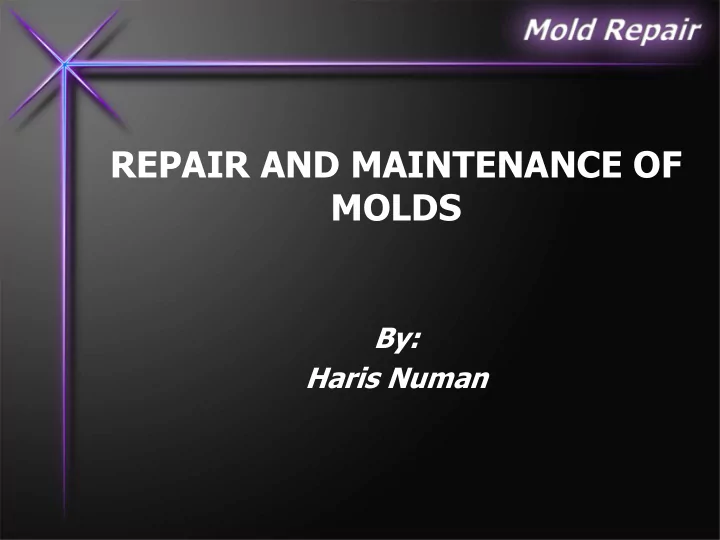

REPAIR AND MAINTENANCE OF MOLDS By: Haris Numan
TYPES OF MOLD DAMAGE & HOW TO IDENTIFY THEM. • Pull Craze • Stress Craze • Front Impact • Rear Impact • Heat Craze
Pull Craze Cause • Difficulty releasing part from mold • Patterns - commonly in bowl shape • Gelcoat has sheared away from laminate
Pull Craze Repair • Remove all gelcoat affected • Flair gelcoat at edges • Check laminate
Pull Craze Repair (continued) • Remove dust and wash down • Spray gelcoat • Post cure
Pull Craze Repair (continued) • Sand • Buff • Apply mold release • Spray and blow gelcoat
Stress Craze Cause • Bending laminate • General damage to laminate • De-laminating gelcoat
Stress Craze Repair • Remove damaged gelcoat and laminate • Flair gelcoat at edges
Stress Craze Repair (continued) • Replace Laminate • Sand repaired laminate • Remove all dust and wash down
Stress Craze Repair (continued) • Spray gelcoat • Post cure
Stress Craze Repair (continued) • Sand • Buff • Apply mold release • Spray and blow gelcoat
Front Impact Cause • Hard impact on gelcoat side of mold • General laminate damage • Circular cracks radiating out from center Repair • Same as stress craze
Rear Impact Cause • Hard impact on laminate side of mold • General laminate damage • Star-like cracks radiating from center of impact Repair • Same as stress craze
Heat Craze Cause • Heating beyond HDT of gelcoat • Thermoshock - repeated heating and cooling • Random straight cracks • Gelcoat can de-laminate over time Repair • Same as pull craze
Repair Procedure • Setup repair area • Pick lines that break light
Repair Procedure • Ensure repair area is clean and dust free • Spray well above original gel height
Repair Procedure • Area must be shaped • Use large, hard sanding block • Start with coarse sand paper 60 to 100 grit • Switch to finer grit 220 • Use hard block until finished
Repair Procedure • Hard block
Repair Procedure • Soft Block
Recommend
More recommend